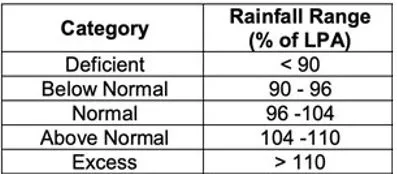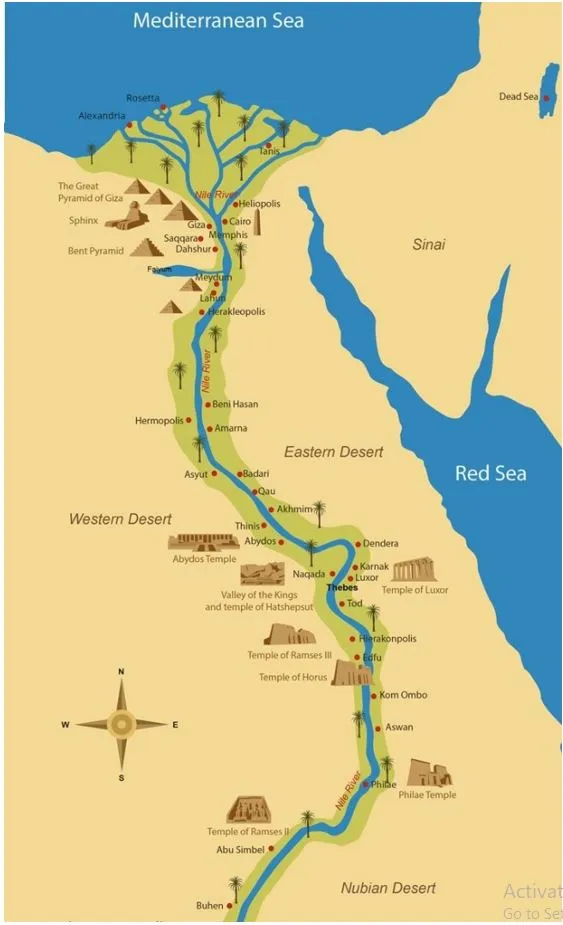

20th May 2024 (13 Topics)
Mains Issues
Context
New Caledonia, nestled in the southwest Pacific, has been shattered by recent violence. Massive riots and armed clashes between indigenous Kanak pro-independence protestors and security forces have engulfed the capital, Nouméa. This unrest has prompted French President Emmanuel Macron to declare a state of emergency.
About New Caledonia
- New Caledonia is a French overseas territory situated in the southwest Pacific
- New Caledonia, with its population of approximately 270,000 people, boasts a diverse demographic makeup.
- Indigenous Kanak form 44% of the populace, followed by 34% Europeans, predominantly French, alongside other minority groups like Wallisian and Tahitians.
- Notably, Nouméa, the capital, accommodates more than a third of the island's inhabitants.
Relationship between New Caledonia and France
- The relationship between New Caledonia and France is complex. Dating back to its designation as a French overseas territory in 1946, New Caledonia operates with a degree of autonomy within the French legal system.
- While the French President serves as the head of state, the territory maintains representatives in the French Parliament.
- Despite this autonomy, New Caledonia relies on France for crucial matters such as defense and internal security.
- Nouméa Accord: The foundation of the Nouméa Accord in 1998 provided a pathway towards gradual autonomy for New Caledonia.
- This accord also restricted voting rights, particularly emphasizing the indigenous Kanak and pre-1998 migrants. However, tensions have mounted as France now considers the Accord expired after three self-determination referendums held in 2018, 2020, and 2021.
- The recent turmoil stems from proposed constitutional amendments that aim to extend voting rights to residents with ten or more years of uninterrupted residency.


Mains Issues
Context
On May 18, 1974, India conducted its first nuclear tests under the 'Smiling Buddha' operation in Pokhran, Rajasthan. This historic event marked India's entry into the nuclear club and raised significant international attention.
Background:
- Post-World War II, global alliances shifted, leading to the Cold War between the US and USSR.
- The Nuclear Nonproliferation Treaty (NPT) was signed in 1968 to prevent nuclear weapon proliferation, with P-5 countries (China, France, Russia, the United Kingdom, and the United States) being recognized as nuclear-weapon states.
- Reasons for India's Nuclear Tests:
- India objected to the NPT's discriminatory nature and the lack of obligations for existing nuclear-weapon states.
- Domestically, Indian scientists like Bhabha and Sarabhai laid groundwork for nuclear energy research.
- Political shifts and conflicts, including wars with China and Pakistan, influenced India's decision to pursue nuclear capabilities.
Execution of Pokhran-I:
- The test yielded 12-13 kilotons of TNT and was conducted on Buddha Jayanti, the birth date of Gautam Buddha.
- No radioactivity was released into the atmosphere: The device tested was a fission device and there had been no release of radioactivity in the atmosphere.
- India became the sixth country in the World to conduct a successful Nuclear Test. It was also the first confirmed nuclear weapons test by a country outside the Five Permanent members of the United Nations Security Council.
- Aftermath:
- India faced criticism and sanctions from countries like the US post-Pokhran-I.
- International perception changed gradually, leading to discussions on India's nuclear status and entry into groups like the NSG.
- Efforts for Global Acceptance:
- India's responsible nuclear posture and diplomacy led to gradual acceptance by the international community.
- Efforts to join the NSG continue, with changing stances of various countries and opposition primarily from China.
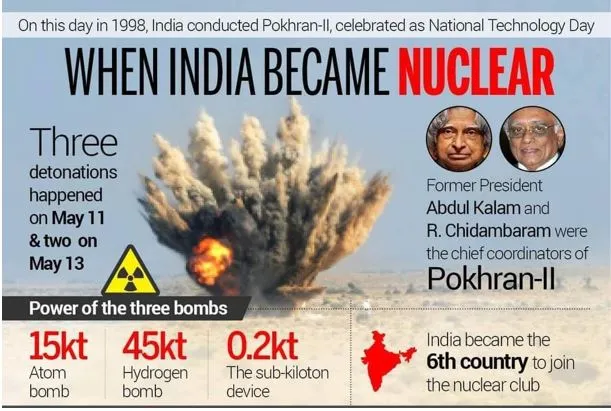
PYQ
|


Mains Issues
Context
Recent agricultural setbacks in India have underscored the vital role of Punjab and Haryana in ensuring the country's food security. These two states, often referred to as the breadbaskets of India, have faced challenges exacerbated by climate phenomena like El Niño.
Wheat Procurement:
- Punjab and Haryana's combined share of wheat procurement for the Central foodgrain pool stands at 75.5% in the current marketing season.
- Together, they fed the public distribution system (PDS) and other government programs.
- Traditionally, these states provided over 90% of wheat for the PDS, but this ratio declined to about 65% by the early 2010s.
- However, in recent years, setbacks from climate shocks have seen Punjab and Haryana's importance rise again.
- Contrast with Other States: States like Madhya Pradesh (MP), Uttar Pradesh (UP), and Rajasthan have seen decreased procurement due to climate impacts. Punjab and Haryana have fared relatively better due to longer winters and favorable sowing times.
- Reasons for higher production:
- The higher yield is possibly because of the Green Revolution, a period when Indian agriculture was converted into an industrial system.
- Modern methods and technology — including high-yielding variety (HYV) seeds, tractors, irrigation facilities, pesticides and fertilisers — were adopted.
|
Wheat Procurement for Central Pool (lakh tonnes) |
|||||
|
|
2019-20 |
2020-21 |
2021-22 |
2022-23 |
2023-24 |
|
Punjab |
127.14 |
132.22 |
96.45 |
121.17 |
122.31 |
|
Haryana |
74.00 |
84.93 |
41.86 |
63.17 |
70.32 |
|
MP |
129.42 |
128.16 |
46.04 |
70.97 |
45.66 |
|
UP |
35.77 |
56.41 |
3.36 |
2.20 |
8.47 |
|
Rajasthan |
22.25 |
23.40 |
0.10 |
4.38 |
8.35 |
|
TOTAL* |
389.93 |
433.44 |
187.92 |
262.02 |
255.24 |
Climate Impact on Wheat Production:
- Climate shocks, like unseasonal temperature surges and heavy rains during critical crop stages, delayed rains have affected wheat yields.
- Recent instances include an unusually warm November-December, impacting wheat yields, especially in central India.
Rice Production:
- Traditionally, Punjab and Haryana dominated rice procurement, but this has diversified to include other states.
- However, recent crop years have seen an increase in the share of procurement from Punjab and Haryana due to favorable conditions.
|
Food Security Programs in India
|
Policy Implications:
- Government schemes like the National Food Security Act (NFSA) heavily rely on procurement from Punjab and Haryana.
- Even with shifts in acreage to other crops, these states will remain crucial for national food security due to their high yields.
Fact Box: Current Situation of Rice Procurement:
|
PYQ
|


Mains Issues
Context
The 1990s marked a period of significant transformation, both in India and globally, leading to the formulation of new policies across various sectors, including the environment. The Rio Summit of 1992 witnessed the birth of crucial international agreements such as the United Nations Framework Convention on Climate Change (UNFCCC) and the Convention on Biological Diversity. Since then, India's approach to climate policy has evolved, driven by its unique geographical, demographic, and socio-economic factors.
Understanding Over-exploitation and Climate Policy:
- Climate change has become a pressing global challenge, exacerbated by unsustainable production and consumption patterns, primarily in developed nations.
- Recent studies highlight that countries like the United States and Europe bear significant responsibility for ecological damage due to overuse of natural resources.
- In contrast, countries like India have managed to stay within their sustainability limits despite their large populations.
- Five Major Determinants of India’s Climate Policy:
- Geography: India's vast landmass and rich biodiversity play a crucial role in shaping its climate policy. The country's diverse ecosystems and seasonal cycles have been disrupted by climate change, leading to adverse impacts on nature and society.
- Population: With a population of over 1.4 billion, India is home to a diverse array of species. Despite its large population density, India strives to strike a balance between population growth and environmental sustainability.
- Impacts: India ranks among the most affected countries by extreme weather events, with climate change projected to have significant economic and social repercussions. Rising temperatures and changing rainfall patterns could adversely affect India's GDP and living standards.
- Worldview: Rooted in ancient philosophies and cultural traditions, India's worldview emphasizes harmony with nature and sustainable living. Gandhi's principles of trusteeship and environmental stewardship continue to influence India's approach to climate action.
- Actions: India's climate policy is characterized by evidence-based decision-making and proactive measures across various sectors. The country has prioritized renewable energy transition, international cooperation, and sustainable development initiatives.
Evolution of India’s Climate Policy:
- India's climate policy has evolved over the years, guided by principles of equity and common but differentiated responsibilities.
- The National Action Plan on Climate Change (NAPCC) of 2008 laid the groundwork for addressing climate challenges through sector-specific missions.
- Additionally, India has actively engaged in international forums, advocating for the interests of developing nations and promoting climate-friendly policies.
- India’s Leadership in Climate Action: India has emerged as a global leader in climate action, emphasizing confidence and convenient actions aligned with inclusive growth principles.
- Initiatives such as the International Solar Alliance (ISA) and the Coalition for Disaster Resilient Infrastructure (CDRI) showcase India's commitment to sustainable development and international cooperation.
- The country's ambitious targets for renewable energy deployment and emission intensity reduction demonstrate its proactive stance towards mitigating climate change.


Prelims Articles
Context
The India Meteorological Department (IMD) announced the onset over the southern Bay of Bengal, the Nicobar Islands, and the South Andaman Sea. What makes this announcement even more exciting is the prediction of above-normal rainfall for the season, a rare occurrence in nearly a decade.
Factors influencing above-normal Monsoon
- A monsoon is a seasonal change in the direction of the prevailing, or strongest, winds of a region.
- Retreat of El Nino: The Indian monsoon is heavily influenced by various factors, including the El Nino and La Nina phenomena in the Pacific Ocean. El Nino brings suppressed rainfall, while La Nina enhances rainfall activity.
- This year, the transition from El Nino to a neutral condition and the likely emergence of La Nina later in the season have set the stage for above-normal rainfall.
- Other factors:
- Favourable La Nina conditions
- Positive Indian Ocean Dipole (IOD)
- Reduced snow cover in Northern Hemisphere
Fact Box: Categorisation (as per IMD)
|
PYQQ: How far do you agree that the behaviour of the Indian monsoon has been changing due to humanizing landscape? Discuss. (2015). |


Prelims Articles
Context
The Indian Meteorological Department (IMD) issued a red alert for heatwaves in Delhi, Punjab, Haryana, and most parts of Western Rajasthan.
Understanding Heatwaves:
- Qualitative Definition: A condition where air temperature becomes dangerously high for humans when exposed.
- Quantitative Definition: Heatwaves are determined based on temperature thresholds:
- In Plains: When maximum temperature reaches 40°C or higher.
- In Hilly regions: When maximum temperature reaches 30°C or higher.
- For Coastal areas: When the maximum temperature departure is 37°C or more than normal.
- Severity Levels:
- Heatwave: Temperature is 4.5°C to 6.4°C above normal.
- Severe Heatwave: Temperature rises more than 6.4°C above normal.
Heatwave Red Alert:
- A red alert signifies an extreme heat warning.
- It indicates a severe heatwave lasting more than two days or a total of more than six heat/severe heatwave days.
- There's a very high risk of heat-related illnesses, including heat stroke, especially for vulnerable populations such as the elderly, infants, and those with chronic diseases.
- Precautionary measures may include early closure of schools to protect children from heat-related risks.
- According to WHO, heatwaves have caused over 166,000 deaths between 1998 and 2017.
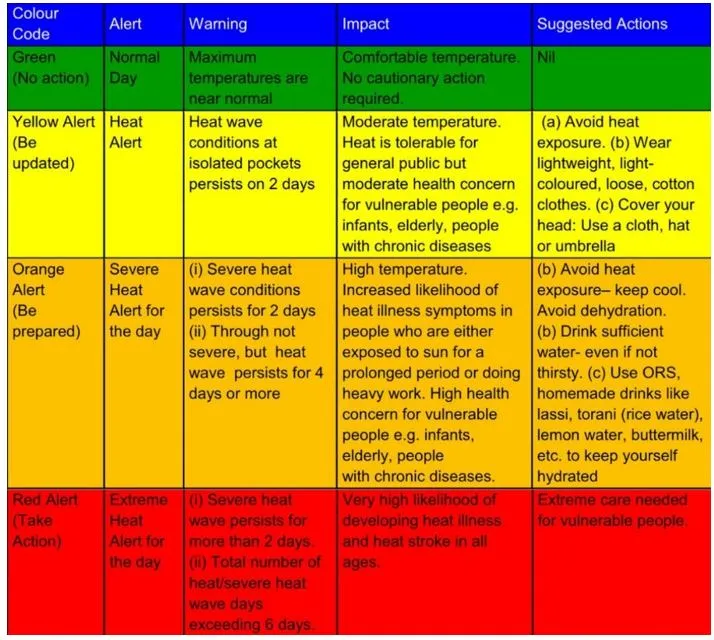


Prelims Articles
Context
A recent study suggests that a long-lost, ancient branch of the Nile could have built the pyramids.
Key-highlights:
- Method: Scientists used radar satellite imagery, geophysical data, and soil coring to find an ancient Nile branch.
- Name: They named the branch "Ahramat." It was around 64 kilometers long and 200 to 700 meters wide. It ran right adjacent to the pyramids and could have been used to move heavy material around.
- Connection to Pyramids: Many pyramids from the Old and Middle Kingdoms had causeways leading to this branch, ending at Valley Temples, possibly acting as river harbors.
- Explanation: The presence of this river explains why 31 pyramids were built in a row along a desert strip in the Nile Valley around 4,700 to 3,700 years ago.
- Significant Sites: This strip near the ancient capital of Memphis includes famous pyramids like the Great Pyramid of Giza, Khafre, Cheops, and Mykerinos.
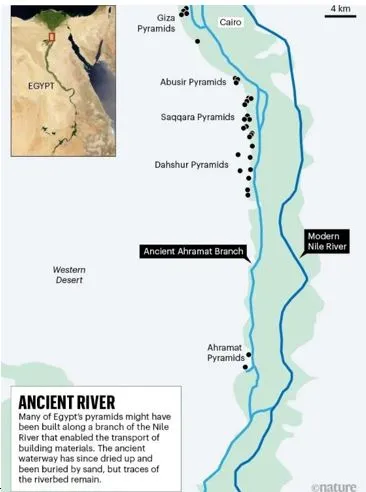
|
Fact Box: Giza Pyramids:
Nile River:
|
|
PYQ: Q: Match List-I with List-II and select the correct answer from the codes: (2017)
Solution: (a) |


Prelims Articles
Context
In recent financial discussions, the nuances of fixed-income mutual funds have garnered attention, especially with the backdrop of potential interest rate changes.
About Fixed-income mutual funds:
- Fixed-income mutual funds can be broadly categorized as open-ended or close-ended.
- Open-ended funds are bought and redeemed directly with the Asset Management Company (AMC)
- Close-ended funds are listed on exchanges for trading.
- Another fundamental concept is accrual, where interest is added to the Net Asset Value (NAV) daily, with market price changes impacting NAV through mark-to-market valuation.
- Categories:
- Liquid Fund: Designed for short-term needs, investing in instruments with maturity up to three months. Primarily earns from accruals, making it suitable for emergency cash-equivalent needs.
- Money Market Fund: Invests in instruments with maturity up to one year, with limited mark-to-market impact. Suitable for short-term investments.
- Banking and PSU Fund: Focuses on instruments issued by banks and PSUs, offering flexibility in portfolio maturity. Ideal for medium-term investment horizons.
- Corporate Bond Fund: Invests in highest credit rating instruments, typically with a portfolio maturity of 3-5 years. Suitable for medium-term investment objectives.
- Dynamic Bond Fund: Allows the fund manager to adjust portfolio maturity based on market conditions. Suited for medium to long-term investment goals.
- Gilt Fund: Invests in government bonds with long maturity, offering exposure to interest rate cycles. Suitable for long-term investment strategies.
- Target Maturity Fund (TMF): Provides a defined maturity date, offering high visibility on returns. Usually maintains high-grade credit quality.


Prelims Articles
Context
The World Health Organization (WHO) latest Bacterial Pathogens Priority List (BPPL) highlights 15 families of antibiotic-resistant bacteria, categorized into critical, high, and medium priorities for intervention.
Key Findings:
- The critical priority pathogens pose significant global threats due to their resistance to treatment and ability to spread resistance to other bacteria.
- The list covers 24 pathogens, spanning 15 families of antibiotic-resistant bacterial pathogens.
|
Critical priority: |
High priority: |
Medium priority: |
|
|
|
- The inclusion of these pathogens in the list underscores their global impact in terms of burden, as well as issues related to transmissibility, treatability, and prevention options.
- It also reflects the R&D pipeline of new treatments and emerging resistance trends.
PYQ:Q: Which of the following are the reasons for the occurrence of multi-drug resistance in microbial pathogens in India? 2019.
Select the correct answer using the code given below
Solution: (b) |


Prelims Articles
|
S.No. |
Term |
About |
|
1. |
Antimicrobial Resistance (AMR) |
AMR renders medicines ineffective against bacteria, viruses, fungi, and parasites. The misuse and overuse of antimicrobials drive AMR, exacerbating the risk of disease spread, illness, and deaths. |
|
2. |
Food security |
Food security is achieved, when all people, at all times, have physical, social and economic access to sufficient, safe and nutritious food to meet their directly needs and food preferences for an active and healthy life. |
|
3. |
Indian Ocean Dipole |
It is a climate pattern affecting the Indian Ocean. During a positive phase, warm waters are pushed to the Western part of the Indian Ocean, while cold deep waters are brought up to the surface in the Eastern Indian Ocean. This pattern is reversed during the negative phase of the IOD. |
|
4. |
Monsoon |
A monsoon is a seasonal change in the direction of the prevailing, or strongest, winds of a region. |
|
5. |
Pathogen |
A pathogen is any organism that causes disease. Viruses, bacteria, fungi, and parasites are all examples of pathogens. |


Editorials
Context
The Ministry of Women and Child Development's notification of the "Scheme for Care and Support to Victims under Section 4 & 6 of the POCSO Act, 2012" has raised concerns due to its misleading nomenclature and inconsistencies in addressing the needs of minor pregnant girl victims.
Oversights and Inconsistencies:
- Misleading Nomenclature and Lack of Redrafting: Confusion arises from the scheme's name, failing to reflect support for all minor pregnant girl victims under the POCSO Act.
- Glaring Oversights: Failure to address scenarios like medical termination of pregnancy (MTP) and changes in victim's circumstances.
- Contradictions with Prevailing Legislation: Errors in referencing POCSO Act sections and misinterpretation of MTP procedures highlight inconsistencies.
Contrary to Rules:
- Requirement for CNCP Categorization: The scheme contradicts existing rules by categorizing all pregnant girls as Children in Need of Care and Protection (CNCP).
- Lack of Clarity on Entitlements: Uncertainty regarding benefits for girls in non-institutional care and deviation from Adoption Regulations raise protocol concerns.
- Monetary Implications: Significant financial burden raises questions about sustainability and adequacy in addressing reported cases of minor pregnant girl victims.
Monetary Implications and Policy Concerns:
- Financial Burden and High Rates of Child Marriages: Analysis of health and police data is necessary to estimate the scheme's impact and devise effective strategies for implementation.
- Lack of Clarity in Implementation: Inefficiencies may arise from inconsistencies, urging the Ministry to rectify shortcomings and align with legislation and protocols.
- Need for Comprehensive Analysis: Accurate estimation of scheme's impact and policy measures are necessary for effectiveness and sustainability.
Mains Question:
Discuss the challenges and inconsistencies in the "Scheme for Care and Support to Victims under Section 4 & 6 of the POCSO Act, 2012".


Editorials
Context
Recent discussions surrounding a government order aimed at ensuring timely payments to Micro, Small, and Medium Enterprises (MSMEs) have highlighted the need for a deeper understanding of the structure and functioning of these enterprises. The order, intended to benefit MSMEs, has inadvertently marginalized smaller enterprises in the short term, underscoring the gaps in knowledge regarding MSMEs.
Need for Systematic Understanding of MSMEs:
- Parliamentary Panel's Deliberations: A parliamentary panel has been examining the possibility of separating micro-enterprises from the broader MSME category, emphasizing the importance of a systematic understanding of enterprises within the MSME ambit.
- Revision of Definition: The standing committee has recommended regular revisions of the MSME definition every five years to ensure its relevance and accuracy.
- Skewed Distribution under Revised Definition: The revision of the micro-enterprise definition in 2020, which increased the turnover threshold to Rs 5 crore, revealed a significant skew in revenue distribution within the category.
Challenges in Data and Classification:
- Discrepancies in Revenue Reporting: Data from various sources, including NSSO surveys and ASI, highlight discrepancies in revenue reporting among micro-enterprises, with a majority reporting annual revenues below Rs 50 lakh.
- Rightward Skewness: Regardless of the dataset used, measures of central tendency such as mean, median, and mode tend to cluster towards the higher end of the micro-enterprise category, indicating a rightward skewness in revenue distribution.
- Lack of Systematic Data: Since 2016, there has been a lack of systematic data on enterprises not registered under the Factories Act, making it challenging to assess the true nature and characteristics of micro-enterprises.
Implications for Policy Design:
- Impact on Intervention Design: Limited understanding of micro-enterprises hampers the design of effective interventions, hindering efforts to address the needs of this significant segment of the economy.
- Need for Review and Classification: There is a pressing need to review and further classify micro-enterprises to reduce opacity and ensure that policy interventions are targeted and effective.
- Importance of Inclusive Data Collection: Enhancing data collection mechanisms to capture the nuances of micro-enterprises' operations and characteristics is crucial for informed policymaking and inclusive economic development.
Mains Question:
Discuss the recent discussions surrounding Micro, Small, and Medium Enterprises (MSMEs) in India, highlighting the gaps in knowledge and challenges in classification.


Editorials
Context
In the United States, the renewal of the Generalised System of Preferences (GSP), to provide economic incentives for developing nations through tariff reductions, is currently stalled, prompting concerns over its implications for global trade and bilateral relations.
Renewing GSP:
- Legislative Hurdles in GSP Renewal: The U.S. GSP program, subject to periodic expiration and renewal by Congress, remains in limbo since its expiration in 2020, despite bipartisan support.
- Importance of GSP for Developing Countries: GSP plays a crucial role in facilitating market access for developing nations, particularly benefiting small businesses and women-owned enterprises, while also promoting economic reforms and sustainability.
- Diverse Support Coalitions: Bipartisan support for GSP renewal is evident, with various stakeholders emphasizing its significance in diversifying supply chains, reducing tariffs, and fostering trade relations, including talks with India.
U.S.-India Trade Relationship:
- Potential of GSP Renewal in U.S.-India Trade Talks: Renewal of GSP could pave the way for broader trade negotiations between the U.S. and India, potentially elevating bilateral trade beyond the current $200 billion mark.
- Previous Negotiations and Potential Trade Scope: Prior negotiations between U.S. and Indian trade representatives hinted at a wide-ranging agreement covering various sectors like medical devices, agriculture, and information technology.
- Limitations in Trade Tools: Despite India's efforts in negotiating FTAs with multiple partners, the U.S. stance on FTAs limits the scope for comprehensive trade agreements, making GSP renewal a crucial avenue for trade enhancement.
Role of GSP in U.S.-India Trade Relations:
- Benefits of GSP Negotiations: GSP renewal offers a strategic opportunity for trade negotiations, addressing areas such as goods, services, labour rights, environmental laws, and regulatory practices, thus bolstering trade ties.
- Alignment with Indo-Pacific Collaboration: Amidst growing strategic collaboration in the Indo-Pacific, leveraging GSP for trade enhancement underscores mutual aspirations for deeper trade relations between the U.S. and India.
- Path Forward for Comprehensive Trade Engagement: While GSP alone may not suffice, its renewal signals a strong commitment towards advancing bilateral trade relations, aligning with broader strategic interests and economic objectives.
Mains Question:
Discuss the significance of the Generalised System of Preferences (GSP) and its role in fostering economic reforms and trade relations between developed and developing countries.


